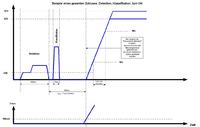so I thought that there are topics about powering devices via twisted pair, i.e. Poe. Maybe let's do this topic dedicated to this kind of power supply.
I am thinking to distinguish between types of Poe because of the standards.
So if I'm wrong, please correct it.
We distinguish pseudo poe which is used with
* poe adapters that is, on the one hand, we let the power supply in and on the other, we take it out - the twisted pair serves as a power transmission medium. The most common power supply is from 12V to 24V
* Poe according to the 802.3 af standard - power supply in the wires 1,2,3,6, i.e. these wires with the data voltage 48v power 15.5w
* Poe according to the 802.3 at standard power supply in 4,5,7,8 wires, i.e. wires not used for data transmission, voltage also 48V, power 30W
The question is where to put HI Poe and poe +?
Moderator's note :
The POE 802.3 af and at standards do not differ in terms of which wires are used to send the power, and most of all the available power. More on this later in the discussion, including in # 7. https://www.elektroda.pl/rtvforum/topic2769837.html#13374801
------------------------------------------------
Announcement
Also read:
How to choose an IP recorder. With or without a built-in switch? Switch selection for monitoring at Choice of topics.
Which means that the camera can be powered by POE / 12V
IP camera signal and power
Connecting a camera without POE, powered from 12V to a switch / recorder with POE
We invite you to read the other guides, highlighted topics, articles in the field of security systems such as intercoms, gate and barrier automation, alarm systems, cameras, access control:
Security Systems Tutorials
If you do not find the answer to your question in the above-mentioned topics, please visit the forum:
Security systems
We also encourage you to visit the General Guides section, where you will find materials from other forum sections, including those for people starting their adventure with electronics:
General Tutorials
I am thinking to distinguish between types of Poe because of the standards.
So if I'm wrong, please correct it.
We distinguish pseudo poe which is used with
* poe adapters that is, on the one hand, we let the power supply in and on the other, we take it out - the twisted pair serves as a power transmission medium. The most common power supply is from 12V to 24V
* Poe according to the 802.3 af standard - power supply in the wires 1,2,3,6, i.e. these wires with the data voltage 48v power 15.5w
* Poe according to the 802.3 at standard power supply in 4,5,7,8 wires, i.e. wires not used for data transmission, voltage also 48V, power 30W
The question is where to put HI Poe and poe +?
Moderator's note :
The POE 802.3 af and at standards do not differ in terms of which wires are used to send the power, and most of all the available power. More on this later in the discussion, including in # 7. https://www.elektroda.pl/rtvforum/topic2769837.html#13374801
------------------------------------------------
Announcement
Also read:
How to choose an IP recorder. With or without a built-in switch? Switch selection for monitoring at Choice of topics.
Which means that the camera can be powered by POE / 12V
IP camera signal and power
Connecting a camera without POE, powered from 12V to a switch / recorder with POE
We invite you to read the other guides, highlighted topics, articles in the field of security systems such as intercoms, gate and barrier automation, alarm systems, cameras, access control:
Security Systems Tutorials
If you do not find the answer to your question in the above-mentioned topics, please visit the forum:
Security systems
We also encourage you to visit the General Guides section, where you will find materials from other forum sections, including those for people starting their adventure with electronics:
General Tutorials




